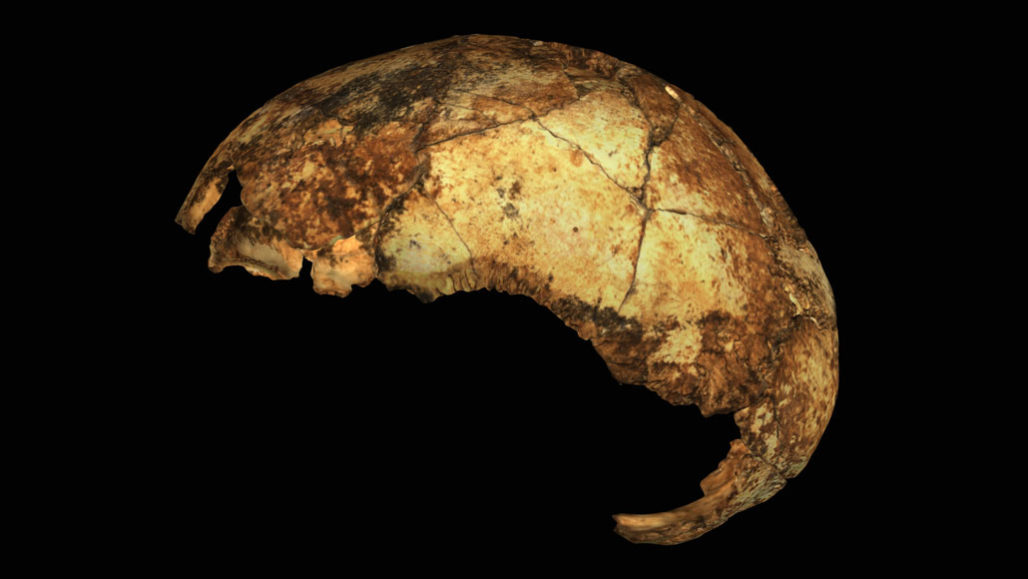Cave excavation yields braincases from both Homo erectus and Paranthropus robustus
Members of three different hominid lines clustered at the bottom of Africa around 2 million years ago, signaling an evolutionary swing propelled by the spread of a highly successful, humanlike species, new fossil discoveries suggest. It’s unclear, though, if the three ancient populations inhabited the region at precisely the same time.
Excavations at Drimolen, a set of caves in South Africa, uncovered two fossil braincases, one from Homo erectus and the other from Paranthropus robustus, say paleoanthropologist Andy Herries of La Trobe University in Melbourne, Australia, and his colleagues. Both finds date to between 2.04 million and 1.95 million years ago, the scientists report in the April 3 Science.
The H. erectus fossil comes from a child who displayed a long, low braincase typical of adults from that species. The P. robustus braincase is that of an adult.
Researchers previously determined that two Australopithecus species, A. africanus and A. sediba (SN: 7/25/13), inhabited nearby parts of South Africa approximately 2 million years ago.
Taken together, these discoveries indicate that a major transition in hominid evolution occurred in southern Africa between around 2.1 million and 1.9 million years ago, Herries’ team says. During that stretch, climate and habitat fluctuations drove Australopithecus species to extinction. H. erectus and P. robustus weathered those ecological challenges, possibly outcompeting Australopithecus for limited resources, the researchers speculate.
It’s unclear whether members of the three hominid lines ever encountered each other during that transition period.
“These spectacular discoveries confirm what some of us have expected for some time, that three genera of [hominids] coexisted in southern Africa,” says paleoanthropologist Darryl de Ruiter of Texas A&M University in College Station, who was not involved in the research.
Earlier work at several other South African cave sites had suggested that H. erectus, P. robustus and A. sediba all dated to nearly 2 million years ago. But many fossils from the first two species are fragmentary, and precise dating of cave sediments that held those finds has proven difficult.
Herries’ team dated the fossil braincases at Drimolen using two techniques for calculating the time since sediments formed just below and above where the specimens were found. Evidence of previously dated reversals of Earth’s magnetic field in Drimolen sediment helped to confirm age estimates for the fossils.
The South African H. erectus fossils may be slightly older than those of A. sediba, but a controversial proposal that A. sediba was an ancestor of the Homo genus remains in play, de Ruiter says. Researchers don’t know how much earlier than 2 million years ago A. sediba originated or how far it ranged beyond its one known fossil site in South Africa. Even so, some other researchers consider A. sediba a dead-end species and regard East Africa as the best bet for where Homo originated.
Unearthing an H. erectus fossil dating to around 2 million years ago in South Africa considerably expands that species’ range at an early stage of its evolution, says paleoanthropologist John Hawks of the University of Wisconsin–Madison. H. erectus fossils in western Asia date to about 1.8 million years ago (SN: 10/17/13). And H. erectus may have made 2.1-million-year-old stone tools in China (SN: 7/11/18).
“It’s possible that this child from Drimolen is the earliest-known representative of the first global [hominid] species,” says Hawks, who did not participate in the new study.
H. erectus’ last known appearance was as late as 108,000 years ago on an Indonesian island, meaning it survived about 2 million years (SN: 12/18/19).
The H. erectus fossil found at Drimolen “marks the beginning of the most successful species of Homo ever known — present company included,” writes paleoanthropologist Susan Antón of New York University in a commentary published with the new Science report.













![Hotstar Premium Cookies 2019 [*100% Working & Daily Updated*] Hotstar Premium Cookies 2019 [*100% Working & Daily Updated*]](https://tahav.com/wp-content/uploads/2019/11/Hotstar-Premium-Cookies-Free-100x70.jpg)



